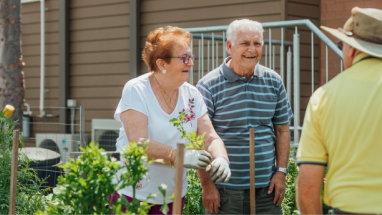The Aged Care Royal Commission revealed a significant increase in demand for aged care. It’s a challenge for government as the number of people aged over 85 is predicted to nearly double from 2.0% of the Australian population in 2018 to 3.7% in 2058.
As Australia ages, older people are choosing to remain in their home for as long as possible. That’s why around two-thirds of people who access aged care services do so from their home. The government has implemented various policies to assist people to stay in their own homes, including tax concessions and more aged care services in the community. Let’s step through the main community care options for your clients.
1. Downsizing (including moving in with family)
Clients that seek to move into more age-appropriate accommodation have a variety of choices. These can include moving to a smaller or easy-access home (such as a ground floor unit), moving in with family, a co-ownership arrangement with family or a granny flat interest. A granny flat interest is a right to accommodation in a property that the client doesn’t own. It doesn’t necessarily have to be a separate dwelling out the back of someone’s property and can be useful from an estate planning, social security and aged care point of view.
If any of these downsizing arrangements involve the sale of a primary residence, consider a downsizer contribution to superannuation. To be eligible, your client must be over age 55, have owned the residence for at least 10 years prior to disposal and make the contribution within 90 days of receiving the proceeds.
2. Lifestyle villages
Also called land lease communities or manufactured home estates, a person will own the house and pay rent to lease the land. Covered by state-based tenancy laws, lifestyle villages look like and offer similar facilities to retirement villages such as pools, bowling greens and club houses. From a social security perspective, the client is a homeowner and the house is an exempt asset. Centrelink recipients may be eligible for rent assistance towards their land lease fees. Other advantages include no stamp duty, no rates and generally no exit fees. A key benefit is that the resident can sell their home to a new resident on departure at the market price.
3. Retirement villages
A retirement village is a community for people aged over 55 that’s regulated by state-based retirement village legislation. It’s not an aged care facility, although some retirement villages may have aged care facilities attached or nearby. The units range from self-care to independent living through to higher levels of care.
A retirement village can have different fee arrangements to enter,commonly this would be a licence to occupy or a leasehold type of arrangement. Your client would generally pay a lump sum entry contribution, an ongoing levy and an exit fee. Moving to a retirement village is a lifestyle purchase rather than an investment. Historically capital growth from a retirement village unit is generally significantly lower than the capital growth from a freehold type of property such as a strata apartment.
4. Commonwealth Home Support Programme
The Commonwealth Home Support Programme is intended to provide entry level home support services to people aged over 65. The program helps people with daily tasks while at home and in the community. To access the program, a person needs to organise a health-based assessment with the Regional Assessment Service through My Aged Care. The government-subsidised services provided include the well-known ‘Meals on Wheels’, help with basic chores around the house or garden, assistance with shopping and transport to medical appointments.
5. Home care packages
Home care packages are for people who need a higher level of support. To access the program, a health-based assessment is done by the Aged Care Assessment Team (ACAT) through My Aged Care. Once someone’s approved for a package, an amount is allocated to that individual who’ll then need to choose a home care service provider. The service provider will work with the package recipient to come up with a care plan and will manage the recipient’s individualised budget to provide the care and the services needed. The provider is responsible for managing the funds, scheduling, and paying carers to help the person in their home
Learn more
For more information about care options and the financial and social security implications of each please email wmtechservices@amp.com.au.
Talk to us
To find out more about our innovative retirement accounts and strategies to help your clients make more of their retirement funds.
MyNorth Lifetime
Our award-winning retirement solutions can help your clients access more Age Pension and higher retirement income that never runs out.

Sandstone Insights - December Best Ideas
09 December 2025 Sandstone Insights have updated their Best Ideas list with the latest recommendations for December. Read more
Stores of Value: Part 2 - Bitcoin
04 December 2025 This second instalment in an educational series on the role of store of value investments focuses on bitcoin. Read more
A new lens on retirement: helping clients live - not hold back
13 November 2025 Retirement isn’t just about having enough money. It’s about knowing how to spend it with confidence. Discover how advisers are using IRIS solutions to help clients live in retirement and not hold back. Read moreImportant information
The information on this page has been provided by NMMT Limited ABN 42 058 835 573, AFSL 234653 (NMMT). It contains general advice only, does not take account of your client’s personal objectives, financial situation or needs, and a client should consider whether this information is appropriate for them before making any decisions. It’s important your client consider their circumstances and read the relevant product disclosure statement (PDS), investor directed portfolio guide (IDPS Guide) and target market determination (TMD), available from northonline.com.au or by contacting the North Service Centre on 1800 667 841, before deciding what’s right for them.
MyNorth Investment and North Investment are operated by NMMT. MyNorth Investment Guarantee is issued by National Mutual Funds Management Limited ABN 32 006 787 720, AFSL 234652 (NMFM). MyNorth Super and Pension (including MyNorth Lifetime), MyNorth Super and Pension Guarantee and North Super and Pension are issued by N.M. Superannuation Proprietary Limited (ABN 31 008 428 322, AFSL 234654 (NM Super) as trustee of the Wealth Personal Superannuation and Pension Fund (the Fund) ABN 92 381 911 598. NMMT issues the interests in and is the responsible entity for MyNorth Managed Portfolios. All managed portfolios may not be available across all products on the North platform. All of the products above are referred to collectively as MyNorth Products. The information on this page is provided only for the use of advisers, it is not intended for clients. This page provides a brief overview of some of the benefits of investing in MyNorth Products. The adviser remains responsible for any advice/services they provide to clients including making their own inquiries and ensuring that the advice/services are appropriate and in accordance with all legal requirements.
You can read the Financial Services Guide online for more information, including the fees and benefits that companies related to NMMT, N.M. Superannuation Proprietary Limited ABN 31 008 428 322, AFSL 234654 (N.M. Super) and their representatives may receive in relation to products and services provided.
North and MyNorth are trademarks registered to NMMT.
All information on this website is subject to change without notice.